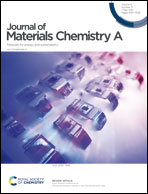Mitigating the P2–O2 transition and Na+/vacancy ordering in Na2/3Ni1/3Mn2/3O2 by anion/cation dual-doping for fast and stable Na+ insertion/extraction†
Abstract
P2-type Na2/3Ni1/3Mn2/3O2 is one of the most promising cathode candidates for sodium-ion batteries due to its high specific capacity and high working voltage. However, a detrimental P2–O2 phase transition usually occurs at a high voltage (>4.2 V) leading to poor cycle stability. Herein, we propose to mitigate this critical issue through a controlled F−/Ca2+ dual-doping strategy with CaF2 as a dopant. The divalent Ca2+ ion doped in the Na layer stabilizes the layered structure at a high voltage when excessive Na+ is extracted. The more electronegative F− ion forms a stronger transition metal (TM)–F bond and reduces the electrostatic repulsion between the oxygen layers impeding the gliding of TMO2 layers. The Ca2+/F− co-doping successfully suppresses the unfavorable P2–O2 phase transition, and significantly improves the structural stability and cycling performance (27.1% vs. 87.2% after 500 cycles at 1C). Furthermore, density functional theory calculations combined with experimental tests reveal that the incorporation of Ca2+ and F− in Na sites and O sites facilitates the electronic and ionic conductivity owing to Na+/vacancy disordering, which enhances the high-rate capability. This study provides some insights into the design of long-life and high-rate cathode materials for sodium-ion batteries.



 Please wait while we load your content...
Please wait while we load your content...